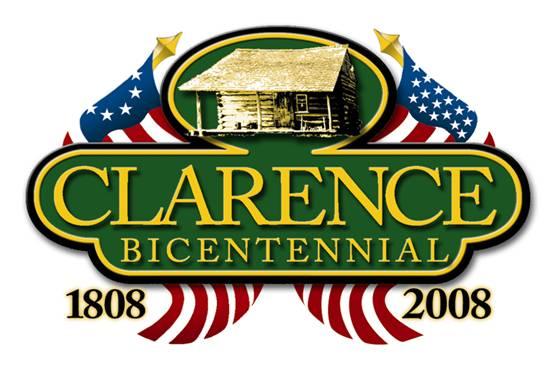The Historic Preservation Commission is devoted to protecting and enhancing the landmarks and historic districts which represent distinctive elements of the Town of Clarence’s historic, architectural, social, economic, and cultural heritage. Through the preservation of local historic landmarks the Commission intends to foster civic pride in the accomplishments of the past, protect the Town’s attractiveness to visitors, and promote the use of historic districts and landmarks for the education, pleasure and welfare of our residents. Ultimately, preservation efforts help to insure the harmonious, orderly, efficient growth and development of the Town, while safeguarding the crucial historic, aesthetic and cultural heritage as embodied and reflected in such landmarks.
Through the work and dedication of its members, the Historic Preservation Commission of the Town of Clarence has been recognized as a Certified Local Government as per the United States Department of the Interior National Park Service. As a Certified Local Government, the Commission is eligible to apply for specially earmarked grants in an effort to better serve the residents of the Town.
Those properties that have received official Historic Landmark status through both the desire of property owners and the assistance of the Historic Preservation Commission are listed below. If you are a property owner interested in a nomination for Historic Landmark status, please review the application and local law available below. Any further questions regarding the Commission, its members, or applying for Landmark status, can be directed to the Office of Planning and Zoning at (716) 741-8933 or by emailing aschaefer@clarence.ny.us
Articles and Research
- Historic Resources Intensive Level Survey
- Reconnaissance Level Survey of Barns and Agricultural Structures
- Historic Research for 10594 Main Street
- Historic Research for 4510 Ransom Road
- Western NY Heritage - Pioneer Preacher Glezen Fillmore
- Western NY Heritage - Genial Genius
- Western NY Heritage - A Tavern within the Trees
- Ransom's Tavern
- Ransom's Tavern Video
- History of the Resource-Ransom's Tavern
Forms and Information
- Town of Clarence Historic Preservation Local Law
- Nomination for Historic Landmark Status Application
- Certificate of Appropriateness Application Form
- Properties nominated as a Local Historic Landmark require a Certificate of Appropriateness from the Historic Preservation Commission for any construction that would alter the exterior facade or appearance of the structure.
- Historical Review Demo Permit Application
- Town of Clarence Historic Preservation Commission Regulation 1
- Pursuant to Clarence Town Code § 117-4 (D) (2)
- For historical review under Section 69-1(C) for all structures constructed prior to 1950, the Historic Preservation Commission shall require a certified title search from the first recorded source of title from the Holland Land Company to carry out its duty of determining whether any historic significance exists for the structure proposed for demolition. This requirement may be waived by the Historic Preservation Commission at its discretion for hardship or good cause shown.
- Duly adopted by vote of the Historic Preservation Commission on May 10, 2021.
Please be advised that the following properties have been nominated as Local Historic Landmarks. As such, any construction that would alter the exterior façade or appearance of the structure requires the review and Certificate of Appropriateness as per the Historic Preservation Commission.
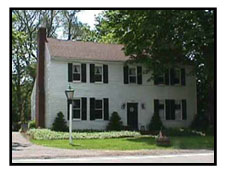
1. 10897 Main Street
The Brace House (named after the owner at the time of nomination) serves as a significant example of the Colonial building type. The home features side gabling, a salt box plan, symmetric façade with a central framed entrance, regular fenestration with shuttering, and a side exterior brick chimney. The interior of the home provides occupants with an excellent record of historic beam construction
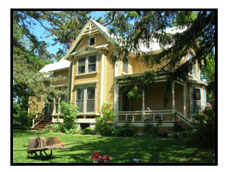
2. 6020 Goodrich Road
This 2 ½ story Victorian Stick home increases the character of the Clarence Center hamlet with distinct Stick building components. These elements include cross gabling, decorative door and window enframements, corner boards, brackets, gable trim, and molding. A stone foundation and converted carriage house/garage increase the historic appeal of this home. It is important to note that Andrew G. Eshelman, a merchant and land owner who developed much of Clarence Center, hired Jacob Fisher to construct the "Birch Lawn Home" in 1885
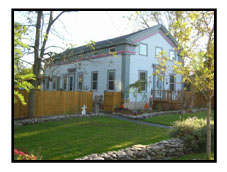
3. 10847 Main Street
This 2-story Greek Revival home is located within the Clarence Hollow hamlet. This property features distinct Greek Revival building components including a wood clapboard exterior featuring a symmetric façade and central entrance enframement, even fenestration with modest trim and framing, and corner pilasters, end returns, and gable trim.
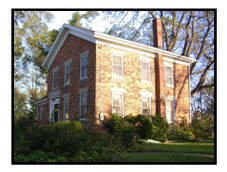
4. 10525 Clarence Center Road
The Light House (named after the current owners) is a 2 ½ story Greek Revival home with brick exterior. The distinct building components include side gabling, regular patterned fenestration with stone sills and lintels, and modest detail trim. As is common of the Greek Revival style, the home also features entrance enframement. Finally, rough cut stone foundation and visible brick chimney reinforce the historic appeal of this home.
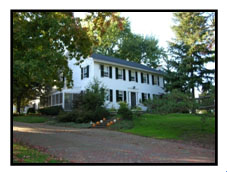
5. 4830 Thompson Road
2 story Colonial structure featuring a brick exterior. The Orchid Ledge farm features distinct building components including side gabling and an originally centered façade entrance with pedimented enframement and sidelights. The home features regular, even fenestration with shuttering. The side enclosed porch and brick chimneys at the ridge on either side reinforce the Colonial appeal of this home. The property was originally owned by the Thompson Family and stayed within the family for over 100 years. The home is in excellent condition and also features a large intact barn that was built in the Pennsylvania Dutch style.
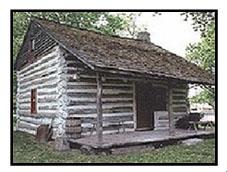
6. 10465 Main Street- Landow Log Cabin
Constructed prior to 1825, the Landow Log Cabin has been accurately restored and serves the community as the best surviving Yankee log cabin in Erie County. The cabin was originally located on the east side of Goodrich Road, just north of Lapp Road. The Landow-Goodrich Log Cabin currently exists on the grounds of the Clarence Historical Museum and provides visitors with an educational and unique piece of Clarence history.
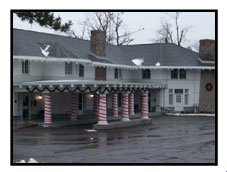
7. 10405 Main Street
Located on the grounds of the Main Town Park within the historically significant and culturally valuable Clarence Hollow hamlet, the Town Park Clubhouse was originally constructed in 1911 and stands as an excellent example of craftsman style architecture. The Clubhouse is culturally significant given its association with the Buffalo Automobile Club and its designers, Esenwein and Johnson, noted late nineteenth to early twentieth century architects based in Buffalo.
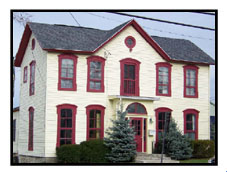
8. 10748 Main Street
The Magoffin House, as named because of its association with James Magoffin, who settled in the Town of Clarence and was named Supervisor in 1874, serves as an excellent example of an Italianate variation structure. Located within the Clarence Hollow hamlet, the Magoffin House compliments the historic and cultural value of the hamlet.
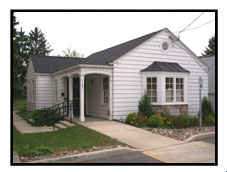
9. 10871 Main Street
The Gerber Library serves the community as an excellent example of a cross gable frame building within the Clarence Hollow hamlet. Originally constructed in 1936, the Gerber Library offers significant architectural components and cultural value due to its association with Esther Gerber, who ran a circulating library from her home at 10882 Main Street.
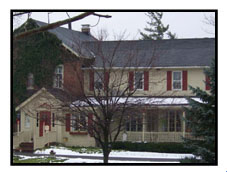
10. 10529 Main Street
Originally constructed in 1853, the Asa Ransom House serves the community as an excellent example of the Colonial building type. Located within the historic Clarence Hollow hamlet, the Asa Ransom House features distinct architectural components and is culturally significant for its association with Asa Ransom and Reuben Ebersole. In 1803, Asa Ransom, the "Founding Father" of Clarence built a mill on the site of the home and more than a century later the mill and home became the property of the Ebersole family, successful proprietors in the community.
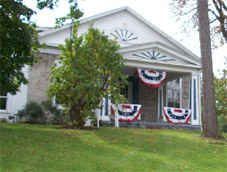
11. 10465 Main Street- Clarence Historical Museum
The Museum is significant as a rare mid-nineteenth century stone Greek Revival building example. Situated in the rear of the property, is a three bay stone addition, and relocated barns and outbuildings. The location is significant in that it is part of a 144 acre lot originally purchased by Asa Ransom in 1803.
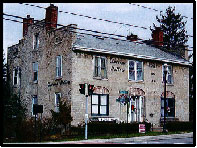
12. 10768 Main Street- Spoors Hotel
Constructed circa 1810 – 1812, the Spoors Hotel remains one of the oldest surviving buildings in Erie County and the Town of Clarence. William Spoor opened the building for business as a hotel in the midst of the War of 1812. The names of operation have changed over the years, including its function as a stop on the stage coach mail route until circa 1870; however, its historical significance has stood firm. Local lore includes a claim that three former United States Presidents have stayed there: Monroe, Fillmore, and Cleveland.
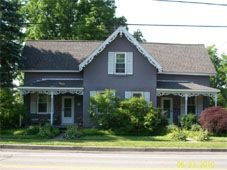
13. 9455 Clarence Center
The Hoffman Home is a 2 story, Victorian folk with Gothic Revival influences that contribute to the rural character that is Clarence Center. The residence includes a stone foundation, extensive ("Gingerbread") trim detail, and a cross-gabled design. The home features a large, converted carriage house/garage in the rear of the property. Constructed in 1850, it was the home of Jacob Eshelman, patriarch of Clarence Center.
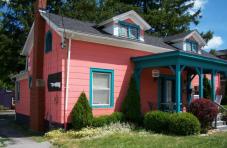
14. 10622 Main Street
This 2-story home is located on north side of Main Street in the historic Clarence Hollow Hamlet. Constructed in the latter half of the 19th century, this home represents characteristic styles from that time era. The residential structure is architecturally a National Folk style home, with a barn that was converted into a carriage house in the rear. The house was home to the Humbert Family, who were well known prominent business and political figures in the town. The first floor has the original heavy safe used in the Humbert Pharmacy and the second floor has original period arched windows.
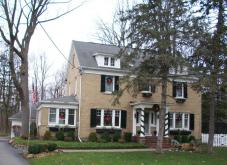
15. 4150 Harris Hill Road
The property is in a historically significant location dating back to Harris Hill’s association with the War of 1812. Originally constructed 1920, this residence is a significant example of a Colonial Revival building. This 2½-story home has been deemed a significant contributor of historical value by Clinton Brown Architecture. Its external features include a side gabled roof, old windowing with wood shutters, a brick exterior, and a stone wall that accents the entrance way.
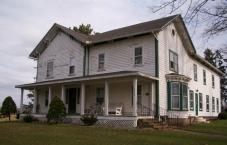
16. 6879 Salt Road
This Victorian Vernacular Folk style home embodies the housing type of the industrial revolution era. Built in 1824, the home represents the rural, agricultural character of the Clarence community at the turn of the 19th Century. The original owners of the property were the Hunt Family. The Hunt’s involvement in farming led to the naming of Hunt’s Corners Road. The 2½ -story home consists of wood clapboard exterior, a large open porch, stone foundation, an oculus window underneath the gabled peak, and two barns in the rear. The home’s architectural styling maintains much of the original character and construction.
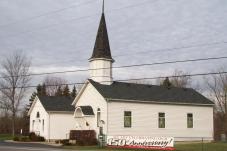
17. 8520 Tonawanda Creek Road
The St. Stephens United Church was originally founded on April 25, 1862 along with the adjoining cemetery. The church had a prominent German following and original records kept by the church were recorded in German. In 1989, the church suffered damage by a fire that destroyed the social hall, but no damage incurred to the sanctuary itself. The building is a simple frame, vinyl sided chapel accompanied by a parish house of underlying character. Located in the northern portion of Clarence, the church consists of Italianate architecture and is a long standing religious institution in the community.
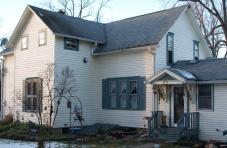
18. 4765 Ransom Road
Located in the Clarence Hollow Hamlet, on the east side of Ransom Road. This home was constructed prior to the Civil War, circa 1860, with the original intact barn. The house represents a unique example of American Folk style architecture and increases the aesthetic value of the Clarence Hollow. The primary entrance of the home is protected by an open porch. The residential structure consists of a two-story cross-gabled frame, with the original stone foundation, and the original leaded glass windows.
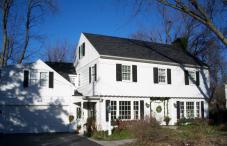
19. 10700 Boyd Drive
The Property located at 10700 Boyd Drive features a primary residence that offers distinct components of a local Colonial Revival Home. Originally built in 1947 and located within the Clarence Hollow Hamlet, the 2 ½ story home features a side gabled and is 3 bays wide by 2 bays deep. The residence has wood clapboard as well as vertical board siding on the second story. Colonial Revival became a popular American house style after it appeared at the 1876 the US Centennial Exposition. Reflecting American patriotism and a desire for simplicity, the Colonial Revival house style remained popular until the mid-1950's.
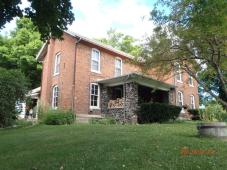
20. 6110 Salt Road
Built in 1872, the residence at 6110 Salt Road is a great example of the Italianate style, which was popular from around 1850 to 1880. This two-story, cross-gabled residence includes low-pitched roof lines with wide overhanging eaves and tall, narrow windows with segmentally arched heads typical of the Italianate style. It also features exterior brick masonry wall construction, a stone belt course and rusticated stone foundation walls. Additionally, its unique possible Craftsman-style inspired stone porch compliments the residence. Several period sensitive agricultural outbuildings sit within the property, and complete this historic farmstead.
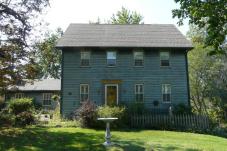
21.4760 Goodrich Road
Constructed circa 1830, this two-story Pennsylvania-German style farmhouse features a four-bay front with an asymmetrical entrance. In addition, it includes a full post & beam structure on a stone foundation, a remaining stone wall in the front yard area, and it is one of the few remaining residences of this style in the area. The property was once owned by John Long, one of the town’s original settlers.
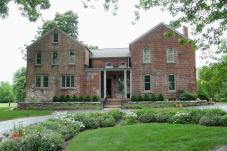
22. 4865 Meadowbrook Road
Constructed around 1850/1860, this two-story full brick Italianate style residence originally fronted to the east and was accessed from the Wenner Road/Sheridan Drive area, but now fronts west to Meadowbrook Road (as Meadowbrook Road was built years after this residence was constructed). The residence features arched windows with stone sills & a stone foundation. The first owner was Pastor John Lapp & the residence was built by Jeremiah Fogelsonger.
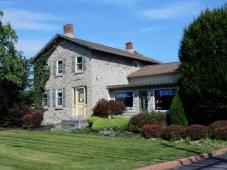
23. 9060 Main Street
Known as the Charles Snell house and believed to have been constructed in the 1820s (maybe as early as 1814) in the classic Federal-style with a front-facing gable, this is a rare surviving stone farmhouse. The original two-story stone structure includes subsequent additions/alterations with siding at the east side and rear. Segments of the stone fence that once surrounded the larger property remain in the area and the existing carriage house is believed to have been constructed circa 1840.
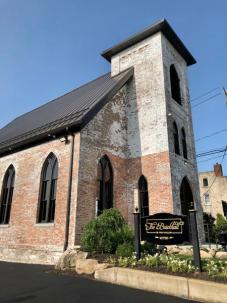
24. 10750 Main Street
The Brickhall, 10750 Main Street, is significant as a rare surviving early nineteenth century brick church. It was associated with the First Presbyterian Church of Clarence, which moved to a larger building in the 1950’s, and now used as a upscale event venue. The original steeple was removed in 1959. The one and one-half story brick building is three bays wide and four bays deep. The center bay is a projecting three-story tower, also brick, topped by a pyramidal roof. The original steeple on the tower was removed in 1959. The main entrance to the building is in the tower and is a set of double doors topped by a lancet arched transom with two lights. In the second story of the tower are two smaller lancet arched openings, and above those, a louvered, lancet-arched belfry. The east and west bays have a thirty-light window.
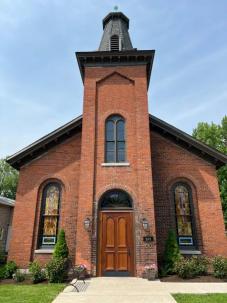
25. 10678 Main Street is a significant, single story mid-nineteenth century vernacular Romanesque Revival style former church, three bays wide and four bays deep. The shallow front-facing gable is broken by a central three story tower and distinctively-shaped steeple. A narrow cornice separates the tower from the steeple. Eight evenly-spaced corner brackets, one each side, resemble dentil molding. Matching cornice brackets are located under the eaves of the main building as well. A flat-roofed one story brick addition is to the rear. The main entrance door is located in the tower. In the second story of the tower is a rounded-top window. On each side of the tower is a large, rounded-top double-hung stained glass window. Four matching stained glass windows are located in the east and west elevations. 10678 Main Street is also significant for its association with the Clarence Church of Christ, first organized in 1834. This church building was built in 1876, dedicated in 1877.
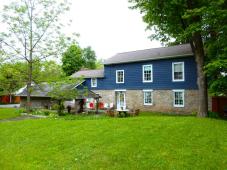
26. 10478 Main Street
The SHOPE HOUSE is significant as a rare, early nineteenth century stone house. A 2-story, side gabled Federal style building. The main block is three bays wide by two bays deep. The first story is stone and the second story is wood shingle. A large cross gabled barn converted is in the rear (northeast). A private bricked courtyard is to the southeast. The primary entrance is in the west elevation. The fenestration is even, with simple trim and detail work.

27. 10545 Main Street
The Hamlin House is significant as a rare nineteenth century building with Greek Revival and Colonial Revival attributes. The original structure features projecting bay windows with three single-pane windows on either side of the center bay, a two-story projecting bay on the west elevation, and a frieze band that runs the full width of the building and continues around the side, ending with the end of the cornice return. The original structure is believed to be built between 1818 and 1820, and it is one of the last remaining original structures of the pioneer village of Clarence Hollow. 10545 Main Street is also significant for its association with the Hamlin Family, the Hilton Family, and the Ransom Family.
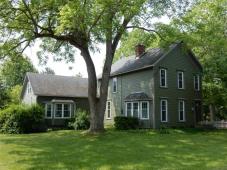
28. 10685 South Park Avenue
Significant as an early twentieth century farmhouse complex. The main block of this Victorian folk frame structure is a 2-1/2 story front-facing gable three bays wide and two bays deep. To the rear (south) is a 1 ½-story addition two bays wide by two bays deep. Adjoining the rear addition to the east is a cross gable 1-1/2 block. All blocks have wood clapboard siding and modest period detailing. To the southwest is an intact period carriage house/garage with board and batten siding, set on a stone foundation. The primary entrance is in the west bay. In the central and east bay are one over one double-hung windows, with three matching windows in the second story. All the windows are enframed and topped by drip molding.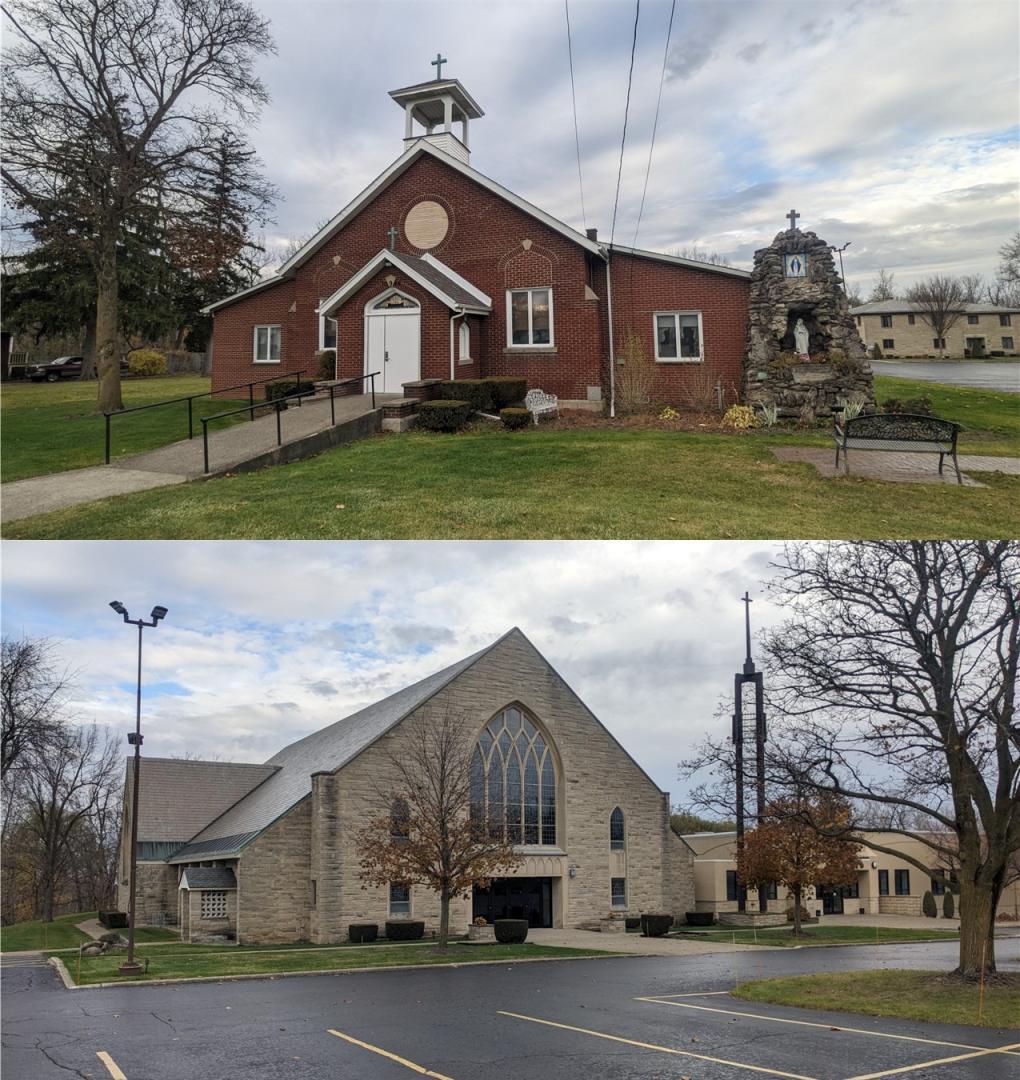
29. 10946-10984 Main Street
Our Lady of Peace: The Church Campus, with notable structures, is an established and familiar visual feature of Main Street (Route 5), the East Hill/Clarence Hollow hamlet, and the surrounding farming community since 1922.
Uriel Hall: The original church, Uriel Hall, was constructed in 1922 by Nelson King and designed by Joseph Giand. It is named for Father John Uriel, pastor of St. Teresa RC Church in Akron, NY. The church design is primarily “Colonial Revival” in form, symmetry, mass, window design and placement and materials. It also includes Arts and crafts inspired detailing such as the masonry details around the window, low masonry walls with cap that flank the main entrance stoop, stained glass windows and shallow arch ceiling of the nave, accentuated with narrow wood bands at the perimeter and composing a pattern of rectilinear forms.
Church: In 1963, the original red brick church, Uriel Hall, was no longer large enough for the growing parish. In 1965, Father John O’Malley built a new church as well as a combination rectory and religious education center. The church was designed by Gerard M. Zimmerman well known for design of other area churches, public buildings and residences. The church and rectory were designed during the mid-century modern era of architectural design. Our Lady of Peace RC Church is a Mid-Century Modern example that combines Post Modern and Neo Gothic Revival design elements.
 Town of Clarence
Town of Clarence
